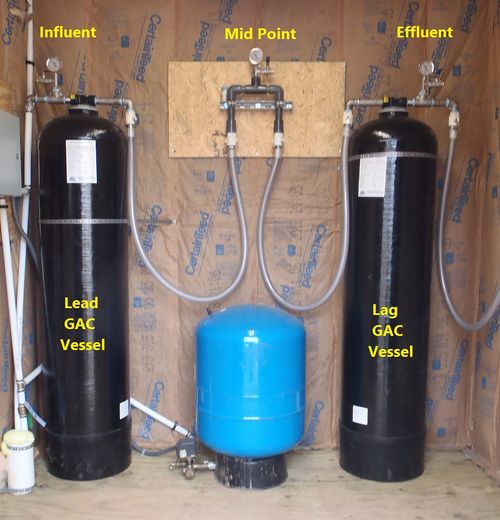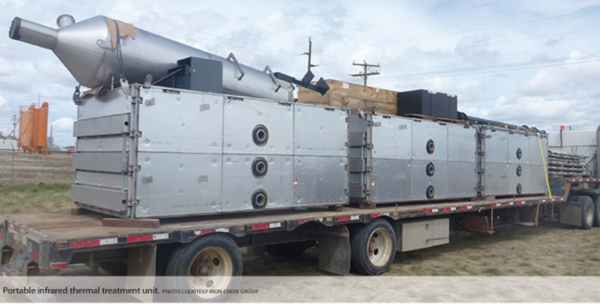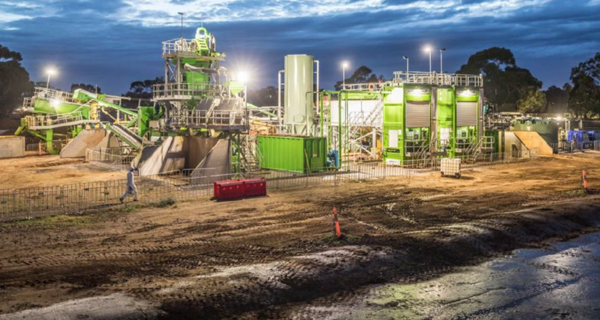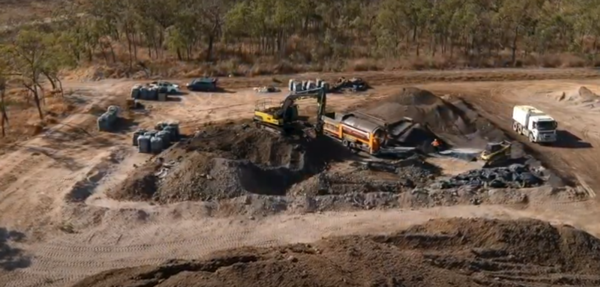User:Jhurley/sandbox
PFAS Ex Situ Water Treatment
Well-developed ex situ treatment technologies applicable to treatment of perfluoroalkyl and polyfluoroalkyl substances (PFAS) in drinking water and non-potable groundwater include membrane filtration (reverse osmosis and nanofiltration), activated carbon adsorption (granular and powdered), and anion exchange. There are also a variety of separation and destructive technologies in developmental stages. Some of these processes may also be applicable to more complex matrices including wastewater and landfill leachate.
Related Article(s):
- Perfluoroalkyl and Polyfluoroalkyl Substances (PFAS)
- PFAS Transport and Fate
- PFAS Sources
- PFAS Soil Remediation Technologies
Contributor(s): Dr. Scott Grieco and James Hatton
Key Resource(s):
Established PFAS Treatment Technologies
Three technologies are well demonstrated for removal of PFAS from drinking water and non-potable groundwater (as described below):
- membrane filtration including reverse osmosis (RO) and nanofiltration (NF)
- granular activated carbon (GAC) and powdered activated carbon (PAC) adsorption
- anion exchange (IX)
However, these technologies are less demonstrated for removal of PFAS from more complex matrices such as wastewater and leachate. Site-specific considerations that affect the selection of optimum treatment technologies for a given site include water chemistry, required flow rate, treatment criteria, waste residual generation, residual disposal options, and operational complexity. Treatability studies with site water are highly recommended because every site has different factors that may affect engineering design for these technologies.
Membrane Filtration
Given their ability to remove dissolved contaminants at a molecular size level, RO and some NF membranes can be highly effective for PFAS removal. For RO systems (Figure 1), several studies have demonstrated effective removal of perfluorooctanoic acid (PFOA) and perfluorooctane sulfonate (PFOS) (see PFAS for nomenclature) from drinking water with removal rates well above 90%[5][6][7]. RO potable water reuse treatment systems implemented in California have also demonstrated effective PFOS and PFOA removal as reported by the Water Research Foundation (WRF)[1]. Analysis of permeate at both sites referenced by the WRF confirmed that short and long chain PFAS concentrations in the treated water were reduced to levels below test method reporting limits.
Full-scale studies using larger effective pore size NF membranes for PFAS removal are limited in number but are promising since NF systems are somewhat less costly than RO and may be nearly as effective in removing PFAS. Recent laboratory or pilot studies have shown good performance of NF membranes[8][9][10][11][12].
Although membrane RO and NF processes are generally capable of providing uniform removal rates relative to short and long chain PFAS compounds (see PFAS for nomenclature), other aspects of these treatment technologies are more challenging:
- Membranes must be flushed and cleaned periodically, such that overall water recovery rates (process water volumes consumed, wasted, and lost vs. treated water volumes produced) are much lower than those for GAC and IX processes. Membrane fouling can be slowed or avoided depending on operating conditions, membrane modifications, and feed modifications[13]. Typically, 70-90% of the water supplied into a membrane RO process is recoverable as treated water. The remaining 10-30% is reject containing approximately 4 to 8 times the initial PFAS concentration (depending on recovery rate).
- These cleaning and flushing processes create a continuous liquid waste stream, which periodically includes harsh membrane cleaning chemicals as well as a continuous flow of concentrated membrane reject chemicals (i.e., PFAS) that must be properly managed and disposed of. Management often includes further treatment to remove PFAS from the liquid waste.
- RO and NF systems are inherently more expensive and complicated systems to implement, operate, and maintain compared to adsorption processes. Treatment system operator certification and process monitoring requirements are correspondingly markedly higher for RO and NF than they are for GAC and IX.
- Water feed pressures required to drive flow through membrane RO and NF processes are considerably higher than those involved with GAC and IX processes. This results in reduced process efficiency and higher pumping and electrical operating costs.
- Membrane systems can also be subject to issues with irreversible membrane fouling, clogging, and scaling or other physical membrane damage and failures. Additional water pretreatment and higher levels of monitoring and maintenance are then required, further adding to the higher costs of such systems.
Activated Carbon Adsorption

Activated carbon is a form of carbon processed to have small pores that increase the surface area available for adsorption of constituents from water. Activated carbon is derived from many source materials, including coconut shells, wood, lignite, and bituminous coal. Different types of activated carbon base materials have varied adsorption characteristics such that some may be better suited to removing certain contaminant compounds than others. Results from laboratory testing, pilot evaluations, and full-scale system operations suggest that bituminous coal-based GAC is generally the best performing carbon for PFAS removal[14][15].
The removal efficiency of individual PFAS compounds using GAC is a function of both the PFAS functional group (carboxylic acid versus sulfonic acid) and also the perfluoro-carbon chain length[16][17](see PFAS for nomenclature):
- perfluoro-sulfonate acids (PFSAs) are more efficiently removed than perfluoro-carboxylic acids (PFCAs) of the same chain length
- long chain compounds of the same functional group are removed better than the shorter chains
Activated carbon may be applied in drinking water systems as GAC or PAC[18][19]. GAC has larger granules and is reusable, while PAC has much smaller granules and is not typically reused. To-date, PAC is most often used as a temporary treatment as costs associated with disposal and replacement of the used PAC may preclude using PAC for long-term treatment. A typical GAC installation for a private drinking water well is shown in Figure 2. Contrary to PAC, GAC used to treat PFAS can be reactivated by the manufacturer, driving the PFAS from the GAC and into off-gas. The extracted gas is then treated with thermal oxidation (temperatures often 1200°C to 1400°C). The reactivated GAC is then brought back to the site and reused. Thus, GAC can ultimately be a destructive treatment technology.
Anion Exchange
Anion exchange has also been demonstrated for the adsorption of PFAS, and published results note higher sorption per pound than GAC[16][20][21]. The higher capacity is believed to be due to combined hydrophobic and ion exchange adsorption mechanisms, whereas GAC mainly relies on hydrophobic attraction. Anion exchange resins can be highly selective, or they can also remove other contaminants based on design requirements and water chemistry. Resins have greater affinity for PFAS subgroup PFSA than for PFCA, and affinity increases with carbon chain length. Anion exchange resins are a viable alternative to GAC for ex situ treatment of PFAS anions, and several venders sell resins capable of removing PFAS. Resins available for treating PFAS include regenerable resins that can be used multiple times (Figure 3) and single-use resins that must be disposed or destroyed after use[20]. Regenerable resins generate a solvent and brine solution, which is distilled to recover the solvent prior to the brine being adsorbed onto a small quantity of GAC or resin for ultimate disposal. This use of one treatment technology (GAC, IX) to support another (RO) is sometimes referred to as a “treatment train” approach. Single-use resins can be more fully exhausted than regenerable resins can and may be a more cost-effective solution for low concentration PFAS contamination, while regenerable resins may be more cost effective for high concentration contamination.
Developing PFAS Treatment Technologies
Numerous separation and destructive technologies are in the developmental stages of bench-scale testing or limited field-scale demonstrations. Some of these are listed in Table 1:
| Stage | Separation/Transfer | Destructive* |
|---|---|---|
| Developing |
|
|
| Maturing and Demonstrated |
|
|
| * There are several other destructive technologies such as alternative oxidants, and activation methods of oxidants, but for the purpose of this article, the main categories are presented here. | ||
Conclusions
The well established processes for removing PFAS from water all produce residuals that require management, and it is likely that newer processes under development will also produce some residuals. Often, it is the residuals that limit the usefulness of the process. For instance, RO and NF may currently provide the most complete treatment of water, but the production of a relatively high volume of PFAS-containing liquid reject (the portion of the liquid that retains the contaminants and is “rejected” from the process) limits their application. Often, a second treatment technology such as an adsorbent is required to support the main technology by concentrating or treating the residuals. As more testing and operational data on adsorbents are generated, it is becoming evident that no adsorbent technology outperforms the others in all cases. Whether GAC, ion exchange or another technology is the most technically efficient and cost effective long term option for a given site depends on influent water geochemistry and contaminant concentrations, treatment standards, co-contaminants, duration of treatment, and required flow rates. New generation adsorbents are rapidly being introduced into the market at “evaluation scale” which may provide advantages over commercially available adsorbents. Several newer technologies are being evaluated in the lab and in the field which include electro-oxidation, heat-activated persulfate, sonolysis, electrocoagulation, low temperature plasma, super critical water oxidation, and foam fractionation. These and other potential treatments for PFAS are still largely in the developmental stage. Several technologies show promise for improved management of PFAS sites. However, it is unlikely that a single technology will be adequate for full remediation at many sites. A multi-technology treatment train approach may be necessary for effective treatment of this complicated group of compounds.
Soil Treatment
Addressing recalcitrant contaminants in soil has traditionally been done through containment/capping or excavation and off-site disposal or treatment. Containment/capping may be an acceptable solution for PFAS in some locations. However, containment/capping is not considered ideal given the history of releases from engineered landfills and restrictions on use of land containing capped soils. Innovative treatment approaches for PFAS include stabilization with amendments and thermal treatment.
Excavation and Disposal
Excavation and off-site disposal or treatment of PFAS-impacted soils is the only well-developed treatment technology option and may be acceptable for small quantities of soil, such as those generated during characterization activities (i.e., investigation derived waste, IDW). Disposal in non-hazardous landfills is allowable in most states. However, some landfill operators are choosing to restrict acceptance of PFAS-containing waste and soils as a protection against future liability. In addition, the US EPA and some states are considering or have designated PFOA and PFOS as hazardous substances, which would reduce the number of facilities where disposal of PFAS-contaminated soil would be allowed[22]. Treatment of excavated soils is commonly performed using incineration or other high temperature thermal methods[2]. Recent negative publicity regarding incomplete combustion of PFAS in incinerators[23] has caused some states to ban PFAS incineration[24].
Stabilization

Various amendments have been manufactured to sorb PFAS to reduce leaching from soil. Although this is a non-destructive approach, stabilization can reduce mass flux from a source area or allow soils to be placed in landfills with reduced potential for leaching. Amendments sorb PFAS through hydrophobic and electrostatic interactions and are applied to soil through in situ soil mixing or ex situ stabilization (Figure 1). Effectiveness of amendments varies depending on site conditions, PFAS types present, and mixing conditions[26]. Good results have been observed in bench and field scale tests with a variety of cationic clays (natural or chemically modified) and zeolites[27][28][29]. Bench-scale tests have shown that activated carbon sorbents reduce leachability of PFAS from soils[30][31][32]. A commercial product developed in Australia (RemBind™) combines the cation exchange binding capability of clays, the hydrophobic sorption and van der Waals attraction of organic material, and the electrostatic interactions of aluminum hydroxide to create a highly effective soil stabilizer. This material has been mixed into soil at 1 to 5% ratio by weight in ex situ applications and been demonstrated to reduce leachability by greater than 99 percent[33].
Thermal Treatment

Incineration: Incineration is a well-developed technology for organics destruction, including PFAS-impacted soils. Incineration is generally defined as high temperature (>1,100°C) thermal destruction of waste, and PFAS are thought to mineralize at high temperatures. Generally, incinerators treat off-gasses by thermal oxidation with temperatures as high as 1,400°C, and vaporized combustion products can be captured using condensation and wet scrubbing[26]. Some regulatory officials have expressed concern about possible PFAS emissions in off-gas from these incinerators, and the authors are not aware of any published evidence demonstrating complete mineralization of multiple PFAS in incinerators at the time of this posting. In general, incineration is designed to provide “5 nines of destruction” – destruction of 99.999% of the contaminants, although incinerators are not designed to specifically treat PFAS to this standard. In the absence of approved industry standard test methods, the US EPA is developing off-gas/stack testing procedures capable of detecting PFAS at the levels considered to be harmful[35].
Thermal Desorption: Thermal Desorption of PFAS from soil has been demonstrated at the field scale in Australia and the US (Alaska)[33] using a rotary kiln operating at temperatures in the range of 900°C or less with treatment times of 10-15 minutes[36]. At these temperatures, some PFAS are mineralized, releasing fluorine that must be captured in off-gas treatment systems. Some PFAS would not be destroyed at these temperatures and therefore must be captured in off-gas treatment systems. Several bench-scale tests have been performed that have narrowed down the optimal temperature for desorption to between 350°C and 400°C[37][25]. A US Department of Defense (DoD) Strategic Environmental Research and Development Program (SERDP) field-scale demonstration was performed in Oregon, where thermal desorption was conducted at 400°C over several days, and the PFAS were captured on vapor-phase activated carbon and incinerated[37]. An in situ thermal desorption project has been funded under the US DoD’s Environmental Security Technology Certification Program (ESTCP) to demonstrate that vadose zone soil can be heated to the requisite 350°C and held there for the appropriate length of time to desorb and capture PFAS from soil source areas[38].
Soil Washing
Soil washing has been applied to PFAS in a handful of pilot projects[39][40][41] and one full-scale implementation in Australia. This approach requires a large-scale engineered plant to handle the various liquid and solid waste streams generated. Soil washing is less suitable for clay-rich soils, where aggregation of the particulates occurs and is difficult to prevent or mitigate. Treatment of the liquid rinse water waste stream is required, which would then rely on conventional water treatment technologies such as granular activated carbon (GAC) or ion exchange. Additionally, in some cases flocculated sludge is generated, which would require treatment or disposal offsite. At present, the only full-scale soil washing demonstration is occurring in Australia, where a vendor has constructed and is operating a 10 million AUD$ treatment plant in anticipation of future treatment of soils generated from remedial actions at Australian Defense installations. Some Australian installations are stockpiling soils due to the lack of cost-effective soil treatment options. According to the vendor, this system generates no solid waste, instead feeding any solids back into the front end of the process for further removal of PFAS[34].
Conclusions
Several well-developed remedial technologies have been applied to address soil contaminated with PFAS. Unfortunately, none of the available techniques are ideal, with some reducing leachability but leaving the PFAS-impacted soil in place, while others result in destruction of the contaminants but require high energy inputs with associated high cost.
References
- ^ 1.0 1.1 Dickenson, E. and Higgins, C., 2016. Treatment Mitigation Strategies for Poly- and Perfluoroalkyl Substances, Report Number 4322. Water Research Foundation, Denver, Colorado. 123 pages. ISBN 978-1-60573-234-3
- ^ 2.0 2.1 Interstate Technology and Regulatory Council (ITRC), 2020. PFAS Technical and Regulatory Guidance Document and Fact Sheets, PFAS-1. PFAS Team, Washington, DC. Website Report.pdf
- ^ Kucharzyk, K.H., Darlington, R., Benotti, M., Deeb, R. and Hawley, E., 2017. Novel treatment technologies for PFAS compounds: A critical review. Journal of Environmental Management, 204(2), pp. 757-764. DOI: 10.1016/j.jenvman.2017.08.016 Manuscript available from: ResearchGate.
- ^ Merino, N., Qu, Y., Deeb, R.A., Hawley, E.L., Hoffmann, M.R., and Mahendra, S., 2016. Degradation and Removal Methods for Perfluoroalkyl and Polyfluoroalkyl Substances in Water. Environmental Engineering Science, 33(9), pp. 615-649. DOI: 10.1089/ees.2016.0233
- ^ Tang, C.Y., Fu, Q.S., Robertson, A.P., Criddle, C.S., and Leckie, J.O., 2006. Use of Reverse Osmosis Membranes to Remove Perfluorooctane Sulfonate (PFOS) from Semiconductor Wastewater. Environmental Science and Technology, 40(23), pp. 7343-7349. DOI: 10.1021/es060831q
- ^ Flores, C., Ventura, F., Martin-Alonso, J., and Caixach, J., 2013. Occurrence of perfluorooctane sulfonate (PFOS) and perfluorooctanoate (PFOA) in NE Spanish surface waters and their removal in a drinking water treatment plant that combines conventional and advanced treatments in parallel lines. Science of the Total environment, 461, 618-626. DOI: 10.1016/j.scitotenv.2013.05.026
- ^ Appleman, T.D., Higgins, C.P., Quiñones, O., Vanderford, B.J., Kolstad, C., Zeigler-Holady, J.C., and Dickenson, E.R., 2014. Treatment of poly- and perfluoroalkyl substances in US full-scale water treatment systems. Water Research, 51, pp. 246-255. DOI: 10.1016/j.watres.2013.10.067
- ^ Steinle-Darling, E., and Reinhard, M., 2008. Nanofiltration for Trace Organic Contaminant Removal: Structure, Solution, and Membrane Fouling Effects on the Rejection of Perfluorochemicals. Environmental Science and Technology, 42(14), pp. 5292-5297. DOI: 10.1021/es703207s Free download from: Academia.
- ^ Appleman, T.D., Dickenson, E.R., Bellona, C., and Higgins, C.P., 2013. Nanofiltration and granular activated carbon treatment of perfluoroalkyl acids. Journal of Hazardous Materials, 260, 740-746. DOI: 10.1016/j.jhazmat.2013.06.033
- ^ Soriano, Á., Gorri, D., and Urtiaga, A., 2017. Efficient treatment of perfluorohexanoic acid by nanofiltration followed by electrochemical degradation of the NF concentrate. Water Research, 112, 147-156. DOI: 10.1016/j.watres.2017.01.043 Author’s Manuscript.
- ^ Zeng, C., Tanaka, S., Suzuki, Y., Yukioka, S., and Fujii, S., 2017. Rejection of Trace Level Perfluorohexanoic Acid (PFHxA) in Pure Water by Loose Nanofiltration Membrane. Journal of Water and Environment Technology, 15(3), pp. 120-127. DOI: 10.2965/jwet.16-072 Free download from: J-STAGE
- ^ Wang, J., Wang, L., Xu, C., Zhi, R., Miao, R., Liang, T., Yue, X., Lv, Y. and Liu, T., 2018. Perfluorooctane sulfonate and perfluorobutane sulfonate removal from water by nanofiltration membrane: The roles of solute concentration, ionic strength, and macromolecular organic foulants. Chemical Engineering Journal, 332, pp. 787-797. DOI: 10.1016/j.cej.2017.09.061
- ^ Le Roux, I., Krieg, H.M., Yeates, C.A. and Breytenbach, J.C., 2005. Use of chitosan as an antifouling agent in a membrane bioreactor. Journal of Membrane Science, 248(1-2), pp. 127-136. DOI: 10.1016/j.memsci.2004.10.005
- ^ McNamara, J.D., Franco, R., Mimna, R., and Zappa, L., 2018. Comparison of Activated Carbons for Removal of Perfluorinated Compounds from Drinking Water. Journal‐American Water Works Association, 110(1), pp. E2-E14. DOI: 10.5942/jawwa.2018.110.0003
- ^ Westreich, P., Mimna, R., Brewer, J., and Forrester, F., 2018. The removal of short‐chain and long‐chain perfluoroalkyl acids and sulfonates via granular activated carbons: A comparative column study. Remediation Journal, 29(1), pp. 19-26. DOI: 10.1002/rem.21579
- ^ 16.0 16.1 McCleaf, P., Englund, S., Östlund, A., Lindegren, K., Wiberg, K., and Ahrens, L., 2017. Removal efficiency of multiple poly-and perfluoroalkyl substances (PFASs) in drinking water using granular activated carbon (GAC) and anion exchange (AE) column tests. Water Research, 120, pp. 77-87. DOI: 10.1016/j.watres.2017.04.057
- ^ Eschauzier, C., Beerendonk, E., Scholte-Veenendaal, P., and De Voogt, P., 2012. Impact of Treatment Processes on the Removal of Perfluoroalkyl Acids from the Drinking Water Production Chain. Environmental Science and Technology, 46(3), pp. 1708-1715. DOI: 10.1021/es201662b
- ^ Dudley, L.A., Arevalo, E.C., and Knappe, D.R., 2015. Removal of Perfluoroalkyl Substances by PAC Adsorption and Anion Exchange. Water Research Foundation Project #4344. Free download of Executive Summary from: Water Research Foundation (Public Plus account)
- ^ Qian, J., Shen, M., Wang, P., Wang, C., Li, K., Liu, J., Lu, B. and Tian, X., 2017. Perfluorooctane sulfonate adsorption on powder activated carbon: Effect of phosphate (P) competition, pH, and temperature. Chemosphere, 182, pp. 215-222. DOI: 10.1016/j.chemosphere.2017.05.033
- ^ 20.0 20.1 Senevirathna, S.T.M.L.D., Tanaka, S., Fujii, S., Kunacheva, C., Harada, H., Shivakoti, B.R., and Okamoto, R., 2010. A comparative study of adsorption of perfluorooctane sulfonate (PFOS) onto granular activated carbon, ion-exchange polymers and non-ion-exchange polymers. Chemosphere, 80(6), pp. 647-651. DOI: 10.1016/j.chemosphere.2010.04.053 Free download from: ResearchGate
- ^ Woodard, S., Berry, J., and Newman, B., 2017. Ion exchange resin for PFAS removal and pilot test comparison to GAC. Remediation Journal, 27(3), pp. 19-27. DOI: 10.1002/rem.21515
- ^ US Environmental Protection Agency (EPA), 2019. EPA’s Per- and Polyfluoroalkyl Substances (PFAS) Action Plan: EPA 823R18004. Washington, DC. Website Report.pdf 2020 Update
- ^ Cheryl Hogue, 2020. Incineration may spread, not break down PFAS. Chemical and Engineering News, American Chemical Society. Website Report.pdf
- ^ New York State Senate, 2020. An ACT prohibiting the incineration of aqueous film-forming foam containing perfluoroalkyl and polyfluoroalkyl substances in certain cities. Website Report.pdf
- ^ 25.0 25.1 DiGuiseppi, W., Richter, R., and Riggle, M., 2019. Low Temperature Desorption of Per- and Polyfluoroalkyl Substances. The Military Engineer, 111(719), pp. 52-53. Society of American Military Engineers, Washington, DC. Open access article. Report.pdf
- ^ 26.0 26.1 Cite error: Invalid
<ref>tag; no text was provided for refs namedITRCwNs2020 - ^ Ochoa-Herrera, V., and Sierra-Alvarez, R., 2008. Removal of perfluorinated surfactants by sorption onto granular activated carbon, zeolites and sludge. Chemosphere, 72(10), pp. 1588-1593. DOI: 10.1016/j.chemosphere.2008.04.029
- ^ Rattanaoudom, R., Visvanathan, C., and Boontanon, S.K., 2012. Removal of Concentrated PFOS and PFOA in Synthetic Industrial Wastewater by Powder Activated Carbon and Hydrotalcite. Journal of Water Sustainability, 2(4), pp. 245-248. Open access article. Report.pdf
- ^ Ziltek, 2017. RemBind: Frequently Asked Questions. Free download Report.pdf
- ^ Du, Z., Deng, S., Bei, Y., Huang, Q., Wang, B., Huang, J. and Yu, G., 2014. Adsorption behavior and mechanism of perfluorinated compounds on various adsorbents – A review. Journal of Hazardous Materials, 274, pp. 443-454. DOI: 10.1016/j.jhazmat.2014.04.038
- ^ Yu, Q., Zhang, R., Deng, S., Huang, J. and Yu, G., 2009. Sorption of perfluorooctane sulfonate and perfluorooctanoate on activated carbons and resin: Kinetic and isotherm study. Water Research, 43(4), pp. 1150-1158. DOI: 10.1016/j.watres.2008.12.001
- ^ Szabo, J., Hall, J., Magnuson, M., Panguluri, S., and Meiners, G., 2017. Treatment of Perfluorinated Alkyl Substances in Wash Water Using Granular Activated Carbon and Mixed Media, EPA/600/R-17/175. US Environmental Protection Agency (EPA), Washington, DC. Website Report.pdf
- ^ 33.0 33.1 Nolan, A., Anderson, P., McKay, D., Cartwright, L., and McLean, C., 2015. Treatment of PFCs in Soils, Sediments and Water, WC35. Program and Proceedings, CleanUp Conference 2015. Cooperative Research Centre for Contamination Assessment and Remediation of the Environment (CRC Care), Melbourne, Australia. pp. 374-375. Free download Report.pdf
- ^ 34.0 34.1 Grimison, C., Brookman, I., Hunt, J., and Lucas, J., 2020. Remediation of PFAS-related impacts – ongoing scrutiny and review, Ventia Submission to PFAS Subcommittee of the Joint Standing Committee on Foreign Affairs, Defence and Trade, Australia. Free download. Report.pdf
- ^ US Environmental Protection Agency (EPA), 2018. PFAS Research and Development, Community Engagement in Fayetteville, North Carolina. Website Report.pdf
- ^ Burke, Jill, 2019. Fairbanks incinerator shows promise for cleaning toxic soil. Channel 2-KTUU, October 8. Website
- ^ 37.0 37.1 Hatton, J., Dasu, K., Richter, R., Fitzpatrick, T., and Higgins, C., 2019. Field Demonstration of Infrared Thermal Treatment of PFAS-impacted Soils from Subsurface Investigations. Strategic Environmental Research and Development Program (SERDP), Project ER18-1603, Alexandria, VA. Website Report.pdf
- ^ Iery, R., 2020. In Situ Thermal Treatment of PFAS in the Vadose Zone. US Department of Defense, Environmental Security Technology Certification Program (ESTCP), Project ER20-5250. Website
- ^ Torneman, N., 2012. Remedial Methods and Strategies for PFCs. Fourth Joint Nordic Meeting on Remediation of Contaminated Sites, NORDROCS 2012, Oslo, Norway. Free download. Report.pdf
- ^ Toase, D., 2018. Application of enhanced soil washing techniques to PFAS contaminated source zones. Emerging Contaminants Summit 2018, Westminster, Colorado.
- ^ Grimison, C., Barthelme, S., Nolan, A., Cole, J., Morrell, C., 2018. Integrated Soil and Water System for Treatment of PFAS Impacted Source Areas, 18E138P. Australasian Land and Groundwater Association (ALGA), Sydney, Australia. Free download. Report.pdf

